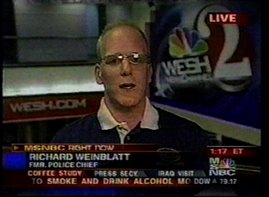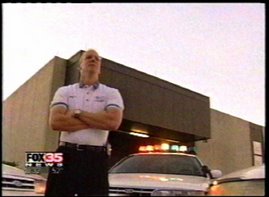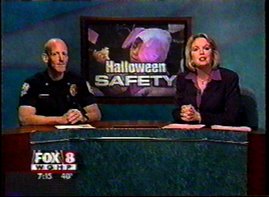Few are those who have not seen the now infamous video of a 17-year-old running on the Philadelphia Phillies ball field and being the recipient of a Philadephia Police officer's well-executed Taser shot. And many have become acquainted with the incident of the man that became disorderly and belligerent while Tiger Woods golfed away in Florida. Yesterday, I did a live via satellite interview with MSNBC anchor Tamron Hall on Taser and sports fans. As a former police chief, Taser instructor, and long-time law enforcement issues media commentator, MSNBC asked me on Sunday if I would appear on the Monday afternoon segment.
The segment had originally been slated to be six minutes or so, but was cut back due to the news surrounding President Obama's United States Supreme Court nomination announcement. I was unable to make a few of points given the time crunch. They also did not air a you tube clip of me being Tasered during training in 2004 that clearly demonstrates that you can be Tasered and walk away (like I did). But, alas, time did not permit. That's understandable as that is the nature of the TV news biz.
Also appearing was Petra DeJesus, a commissioner on the San Fransisco Police Commission. Ms. DeJesus, a civilian lawyer, was appointed to serve on the political commission. Ms. DeJesus is a vocal critic of the Taser and I believe that she is throwing the baby out with the bath water.
While Amnesty International, a great organization whose work I admire, and Ms. DeJesus trumpet deaths attributed to the Taser, they misunderstand the facts and ignore the greater good that Taser has done. I do agree that, much like a firearm or pepperspray, Taser is a tool that can be misused. But when we have bad shoots with a firearm, we do not propose getting rid of the police use of a side arm. Rather, we correctly deal with the individual officer's misconduct.
In the interview, I pointed out that many studies, including a fairly recent one by the U.S. Justice Department, have shown that the Taser is relatively safe. What I did not have time to go into in the interview is the deterrent effect that the red laser dot on the suspect's chest has. As I have stated in HLN Headline News and other media interviews in the past: the best fight for law enforcement to be in is the one that doesn't happen.
Most police officers and deputy sheriffs have seen resistant subjects give up when that red laser dot hits their chest. While they do not fear the firearm as they know it will not be used except in extreme, deadly force situation, they also know that the officer may fire that Taser.
As I opened up the segment, I answered Tamron's question by pointing out that I do not always take the position of the police. I examine each incident on its own merits, based on the information presented, and render an expert analysis. I told Tamron and the viewers that the two incidents at issue: the Philadelphia Phillies and Tiger Woods golf occurrences, appear to be proper uses of the Taser. Philadelphia Police Commissioner Charles Ramsey, former deputy superintendent of the Chicago Police and former Chief of the Washington, DC, Metropolitan Police, had already come out publicly saying that the use of the Taser was within departmental policy guidelines.
I pointed out that if someone were to come in to the Iron Man 2 movie that I saw this weekend and was loud, security would ask him to quiet down. I then took it further through the steps of law enforcement asking him to quiet down, then to leave, then to submit to the arrest that he resisted. The Tiger Woods golf guy was arrested for disorderly intoxication and resisting arrest.
Ms. DeJesus opined that Taser is too large a step to take for someone being disruptive and resisting arrest. I explained in the segment that whether the person is dangerous or not is not known. Law enforcement officers cannot read minds and we do not know what someone's intent is before they make an overt act to demonstrate their purpose.
I mentioned the case of Kansas City Royals first base coach Tom Gamboa who in 2002 lost the hearing in his right ear after two fans attacked him on the ball field. During the attack, a knife even fell out of one of the attacker's pocket. MSNBC host Tamron Hall jumped in agreeing and reminded Ms. DeJesus of the Monica Seles attack.
I said that the police are not mind readers. We do not know what people do before they do it. We in law enforcement can only deal with what we know at the time that we know it. We did not know that the 17-year-old young man who rushed onto the Phillies-Cardinal game field what his intent was. As has been demonstrated by Columbine and other events, teenagers can be dangerous too. That is especially true in the time that we live in.
Getting onto a ball field is not a matter of just stumbling a few steps. One has to overcome physical barriers and other security measures to make a conscious effort to enter the controlled and restricted space. The young man in this incident was charged with defiant trespass.
As for the incident at Tiger Wood's golf outing in Florida, I did not have the time to explain that St. Johns County deputy sheriffs only ended up Tasering the golf fan after security and then law enforcement had asked him to 1) stop, 2) leave, and 3) not resist arrest. The man was charged with disorderly intoxication and resisting arrest. I guess Ms. DeJesus and her ilk would rather that he be beaten into submission with a baton which is sure to cause broken bones and possibly serious injury or death. People forget that that is how it used to be done and the results were not pretty.
Ms. DeJesus in the segment thought that law enforcers should be able to just "muscle" people into compliance. As I mentioned in the interview, there is no magic bullet. Law enforcement officers can't just put their fingers on someone and put them out a la Mr. Spock of Star Trek fame.
I did not have time to point out is that San Francisco's own newly minted star police chief, George Gascon, tried to get his city to approve his drafting of a tightly controlled Taser policy. Interestingly, Ms. DeJesus' own commission voted narrowly four to three to turn down Chief Gascon's request.
Chief Gascon, by the way, is no slouch when it comes to law enforcement expertise. A lawyer himself, Chief Gascon came to San Francisco from his post as chief of the Mesa Police in Arizona. Prior to that, he served with the Los Angeles Police Department rising to the position of Assistant Police Chief and Director of Field Operations under the legendary Chief Bill Bratton.
No mere rubber stamp of hard-line law enforcement types, not all of Chief Gascon's policies were welcomed warmly by the Mesa Police officers. That should give more credibility to his independent assessment and support of Tasers. The device is good for policing and good for the community that law enforcement serves.
San Fancisco is the only big city to not allow it's police officers the less than lethal option that the Taser affords. Other steps such as the baton have been shown to cause more injuries and deaths to officers and suspects when deployed.
What I also did not have time in the MSNBC to elaborate on is that the deaths have been time after time shown to be caused by other factors.
Not five minutes after leaving the TV studios in Columbus, OH, I received an email on my iPhone from a person who thought I was a bad man for supporting the use of Tasers. I get quite a few of these well-intentioned, but ill-informed messages. Without the sender's name being mentioned here, here is the text of his email:
It's unfortunate there are people such as yourself propagating a tool that causes death to stop a 17 kid from running around a ballfield in jest. That cop is an idiot, I don't know how a moron like that could get on the police force. You know what I mean; the taser. Do you have interest in the company that makes these things? I think you may. It's disgusting that there are idiot cops that are stupid enough to use it on harmless citizens. Instaed of teaching cops how to use a taser, why don't you teach them some common sense and how not to be a vigilante? You are just as responsible, and liable for any deaths that these taser's cause, and if I were a judge I would hold you liable in any court of law for the death of anyone killed by your taser's, and pressing the use of these things.
As I mentioned above, the officers did not know the young man's intentions. I don't think it is worth the risk. If something had happened, than folks would be saying why didn't the police do something or do something different. It's a damned if you do and damned if you don't situation.
And, no, I am not in any way compensated nor do I have any financial interest in Taser International, the makers of Taser. Remember, I am not a proponent of the Taser in every situation. The device, however, is a good tool and needs to be available for appropriate and professional use.
Some things that uninformed people, such as Ms. DeJesus and the email sender, are missing in the Taser debate:
- Officer and Suspect injuries and deaths have gone down
- Use of Force incidents have gone down
- The police deal with some people who have risk factors exacerbated since they tend not to have adequate preventative and diagnostic health care
- The police also tend to deal with some people who have ingested drugs such as cocaine and meth.
- Physical confrontations with the police are stressful events in and of themselves. Use of the baton and other physical and mechanical means actually prolongs and intensifies the stressful situation.
- The public overwelmingly in media run polls vote that the use of the Taser is appropriate.
- The public and media overreact and do not understand how the Taser works.
Most coroners have found that deaths come from the above contributory factors. While I fully agree that some Taser usage incidents have been wrong, and I am vocal in my rectifying of those situations, not all Tasers should be eliminated.
In general, the Taser is a useful tool on an officer's tool belt. The key is proper and professional policy formulation, training, supervision, and deployment. Used appropriately, the Taser is the closest thing we have today to Star Trek's stun phaser.




































